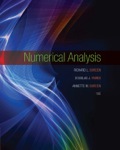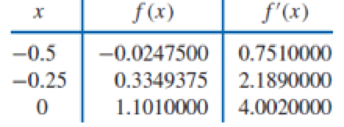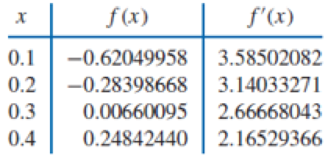
EBK NUMERICAL ANALYSIS
10th Edition
ISBN: 9781305465350
Author: BURDEN
Publisher: YUZU
expand_more
expand_more
format_list_bulleted
Textbook Question
Chapter 3.4, Problem 3ES
The data in Exercise 1 were generated using the following functions. Use the polynomials constructed in Exercise 1 for the given value of x to approximate f (x) and calculate the absolute error.
- a. f (x) = x ln x; approximate f (8.4).
- b. f (x) = sin(ex − 2); approximate f (0.9).
- c. f (x) = x3 + 4.001x2 + 4.002x + 1.101; approximate f (−1/3).
- d. f (x) = x cos x − 2x2 + 3x − 1; approximate f (0.25).
1. Use Theorem 3.9 or Algorithm 3.3 to construct an approximating polynomial for the following data.




Expert Solution & Answer
Want to see the full answer?
Check out a sample textbook solution
Students have asked these similar questions
Harrison and Sherrie are making decisions about their bank accounts. Harrison wants to deposit $200 as a principal amount, with an interest of 2% compounded quarterly. Sherrie wants to deposit $200 as the principal amount, with an interest of 4% compounded monthly. Explain which method results in more money after 2 years. Show all work.
Please type out answer
Mike is working on solving the exponential equation 37x = 12; however, he is not quite sure where to start. Solve the equation and use complete sentences to describe the steps to solve.
Hint: Use the change of base formula: log y =
log y
log b
Using logarithmic properties, what is the solution to log3(y + 5) + log36 = log366? Show all necessary steps.
Chapter 3 Solutions
EBK NUMERICAL ANALYSIS
Ch. 3.1 - For the given functions f(x), let x0 = 0, x1 =...Ch. 3.1 - Use Theorem 3.3 to find an error bound for the...Ch. 3.1 - Prob. 4ESCh. 3.1 - The data for Exercise 6 were generated using the...Ch. 3.1 - Prob. 9ESCh. 3.1 - Prob. 10ESCh. 3.1 - Prob. 11ESCh. 3.1 - Prob. 12ESCh. 3.1 - Prob. 15ESCh. 3.1 - Prob. 17ES
Ch. 3.1 - It is suspected that the high amounts of tannin in...Ch. 3.1 - Prob. 21ESCh. 3.1 - Prove Taylors Theorem 1.14 by following the...Ch. 3.1 - Prob. 1DQCh. 3.1 - If we decide to increase the degree of the...Ch. 3.2 - Let P3(x) be the interpolating polynomial for the...Ch. 3.2 - Nevilles method is used to approximate f(0.4),...Ch. 3.2 - Nevilles method is used to approximate f(0.5),...Ch. 3.2 - Suppose xj = j, for j = 0, 1, 2, 3, and it is...Ch. 3.2 - Nevilles Algorithm is used to approximate f(0)...Ch. 3.2 - Prob. 11ESCh. 3.2 - Prob. 13ESCh. 3.2 - Can Nevilles method be used to obtain the...Ch. 3.3 - Use Eq. (3.10) or Algorithm 3.2 to construct...Ch. 3.3 - Use Eq. (3.10) or Algorithm 3.2 to construct...Ch. 3.3 - Use the Newton forward-difference formula to...Ch. 3.3 - Use the Newton forward-difference formula to...Ch. 3.3 - Use the Newton backward-difference formula to...Ch. 3.3 - Use the Newton backward-difference formula to...Ch. 3.3 - a. Use Algorithm 3.2 to construct the...Ch. 3.3 - a. Use Algorithm 3.2 to construct the...Ch. 3.3 - a. Approximate f(0.05) using the following data...Ch. 3.3 - The following data are given for a polynomial P(x)...Ch. 3.3 - The following data are given for a polynomial P(x)...Ch. 3.3 - The Newton forward-difference formula is used to...Ch. 3.3 - Prob. 14ESCh. 3.3 - Prob. 16ESCh. 3.3 - Prob. 17ESCh. 3.3 - Show that the polynomial interpolating the...Ch. 3.3 - Prob. 20ESCh. 3.3 - Prob. 21ESCh. 3.3 - Prob. 22ESCh. 3.3 - Prob. 23ESCh. 3.3 - Compare and contrast the various...Ch. 3.3 - Is it easier to add a new data pair using...Ch. 3.3 - Prob. 3DQCh. 3.4 - Use Theorem 3.9 or Algorithm 3.3 to construct an...Ch. 3.4 - Use Theorem 3.9 or Algorithm 3.3 to construct an...Ch. 3.4 - The data in Exercise 1 were generated using the...Ch. 3.4 - The data in Exercise 2 were generated using the...Ch. 3.4 - Let f (x) = 3xex e2x. a. Approximate f (1.03) by...Ch. 3.4 - The following table lists data for the function...Ch. 3.4 - a. Show that H2n + 1 (x) is the unique polynomial...Ch. 3.4 - Prob. 1DQCh. 3.4 - Prob. 2DQCh. 3.4 - Prob. 3DQCh. 3.5 - Determine the natural cubic spline S that...Ch. 3.5 - Determine the clamped cubic spline s that...Ch. 3.5 - Construct the natural cubic spline for the...Ch. 3.5 - Construct the natural cubic spline for the...Ch. 3.5 - The data in Exercise 3 were generated using the...Ch. 3.5 - Prob. 6ESCh. 3.5 - Prob. 8ESCh. 3.5 - Prob. 11ESCh. 3.5 - Prob. 12ESCh. 3.5 - Prob. 13ESCh. 3.5 - Prob. 14ESCh. 3.5 - Given the partition x0 = 0, x1 = 0.05, and x2 =...Ch. 3.5 - Prob. 16ESCh. 3.5 - Prob. 21ESCh. 3.5 - Prob. 22ESCh. 3.5 - Prob. 23ESCh. 3.5 - It is suspected that the high amounts of tannin in...Ch. 3.5 - Prob. 29ESCh. 3.5 - Prob. 30ESCh. 3.5 - Prob. 31ESCh. 3.5 - Prob. 32ESCh. 3.5 - Let f C2[a, b] and let the nodes a = x0 x1 xn...Ch. 3.5 - Prob. 34ESCh. 3.5 - Prob. 35ESCh. 3.6 - Let (x0, y0) = (0,0) and (x1, y1) = (5, 2) be the...Ch. 3.6 - Prob. 2ESCh. 3.6 - Prob. 5ESCh. 3.6 - Prob. 1DQ
Knowledge Booster
Learn more about
Need a deep-dive on the concept behind this application? Look no further. Learn more about this topic, subject and related others by exploring similar questions and additional content below.Similar questions
- 4.2 Comparing Linear and Exponential Change 7) Money is added to (and never removed from) two different savings accounts (Account A and Account B) at the start of each month according to different mathematical rules. Each savings account had $500 in it last month and has $540 in it this month. (a) Assume the money in Account A is growing linearly: How much money will be in the account next month? How much money was in the account two months ago? How long will it take for the account to have at least $2500? Write an equation relating the amount of money in the account and the number of months from now. Clearly define the meaning of each variable in your equation, and interpret the meaning of each constant in your equation. (b) Assume the money in Account B is growing exponentially. How much money will be in the account next month? How much money was in the account two months ago? How long will it take for the account to have at least $2500? Write an equation relating the amount of money…arrow_forwardWhich of the following is the solution to the equation 25(z − 2) = 125? - Oz = 5.5 Oz = 3.5 Oz = -2.5 z = -0.5arrow_forwardAnalyze the graph below to identify the key features of the logarithmic function. 2 0 2 6 8 10 12 2 The x-intercept is y = 7, and the graph approaches a vertical asymptote at y = 6. The x-intercept is x = 7, and the graph approaches a vertical asymptote at x = 6. The x-intercept is y = -7, and the graph approaches a vertical asymptote at y = −6. The x-intercept is x = -7, and the graph approaches a vertical asymptote at x = −6.arrow_forward
- Compare the graphs below of the logarithmic functions. Write the equation to represent g(x). 2 f(x) = log(x) 2 g(x) -6 -4 -2 ° 2 0 4 6 8 -2 - 4 g(x) = log(x) - g(x) = log(x) + 4 g(x) = log(x+4) g(x) = log(x-4) -2 -4 -6arrow_forwardWhich of the following represents the graph of f(x)=3x-2? 3 2 • 6 3 2 0- 0- • 3 2 0 -2 3arrow_forward2) Suppose you start with $60 and increase this amount by 15%. Since 15% of $60 is $9, that means you increase your $60 by $9, so you now have $69. Notice that we did this calculation in two steps: first we multiplied $60 by 0.15 to find 15% of $60, then we added this amount to our original $60. Explain why it makes sense that increasing $60 by 15% can also be accomplished in one step by multiplying $60 times 1.15. 3) Suppose you have $60 and want to decrease this amount by 15%. Since 15% of $60 is $9, that means you will decrease your $60 by $9, so you now have $51. Notice that we did this calculation in two steps: first we multiplied $60 by 0.15 to find 15% of $60, then we subtracted this amount from our original $60. Explain why it makes sense that decreasing $60 by 15% can also be accomplished in one step by multiplying $60 times 0.85. 4) In the Read and Study section, we noted that the population in Colony B is increasing each year by 25%. Which other colony in the Class Activity…arrow_forward
- Suppose an experiment was conducted to compare the mileage(km) per litre obtained by competing brands of petrol I,II,III. Three new Mazda, three new Toyota and three new Nissan cars were available for experimentation. During the experiment the cars would operate under same conditions in order to eliminate the effect of external variables on the distance travelled per litre on the assigned brand of petrol. The data is given as below: Brands of Petrol Mazda Toyota Nissan I 10.6 12.0 11.0 II 9.0 15.0 12.0 III 12.0 17.4 13.0 (a) Test at the 5% level of significance whether there are signi cant differences among the brands of fuels and also among the cars. [10] (b) Compute the standard error for comparing any two fuel brands means. Hence compare, at the 5% level of significance, each of fuel brands II, and III with the standard fuel brand I. [10] �arrow_forwardBusiness discussarrow_forwardUse the method of undetermined coefficients to solve the given nonhomogeneous system.X' = −1 33 −1 X + −4t2t + 2 X(t) =arrow_forward
- 5) You are purchasing a game for $30. You have a 5% off coupon and sales tax is 5%. What will your final price be? Does it matter if you take off the coupon first or add in the tax first? 6) You have ten coupons that allow you to take 10% off the sales price of a jacket, and for some strange reason, the store is going to allow you to use all ten coupons! Does this mean you get the jacket for free? Let's really think about what would happen at the checkout. First, the teller would scan the price tag on the jacket, and the computer would show the price is $100. After the teller scans the first coupon, the computer will take 10% off of $100, and show the price is $90. (Right? Think about why this is.) Then after the teller scans the second coupon, the computer will take 10% off of $90. (a) Continue this reasoning to fill in the table below showing the price of the jacket (y) after you apply x coupons. (b) Make a graph showing the price of the jacket from x = 0 to x = 10 coupons applied.…arrow_forwardDetailed report without CHATGPT, accept if you can give with code and plots, previous reported . Do not waste my question.arrow_forwardPlease do not give inappropriate solutions, previous question reported, i need correct report solution for this, NO CHATGPTarrow_forward
arrow_back_ios
SEE MORE QUESTIONS
arrow_forward_ios
Recommended textbooks for you
- Algebra & Trigonometry with Analytic GeometryAlgebraISBN:9781133382119Author:SwokowskiPublisher:Cengage
 Algebra: Structure And Method, Book 1AlgebraISBN:9780395977224Author:Richard G. Brown, Mary P. Dolciani, Robert H. Sorgenfrey, William L. ColePublisher:McDougal Littell
Algebra: Structure And Method, Book 1AlgebraISBN:9780395977224Author:Richard G. Brown, Mary P. Dolciani, Robert H. Sorgenfrey, William L. ColePublisher:McDougal Littell

 College Algebra (MindTap Course List)AlgebraISBN:9781305652231Author:R. David Gustafson, Jeff HughesPublisher:Cengage Learning
College Algebra (MindTap Course List)AlgebraISBN:9781305652231Author:R. David Gustafson, Jeff HughesPublisher:Cengage Learning Elementary Linear Algebra (MindTap Course List)AlgebraISBN:9781305658004Author:Ron LarsonPublisher:Cengage Learning
Elementary Linear Algebra (MindTap Course List)AlgebraISBN:9781305658004Author:Ron LarsonPublisher:Cengage Learning

Algebra & Trigonometry with Analytic Geometry
Algebra
ISBN:9781133382119
Author:Swokowski
Publisher:Cengage

Algebra: Structure And Method, Book 1
Algebra
ISBN:9780395977224
Author:Richard G. Brown, Mary P. Dolciani, Robert H. Sorgenfrey, William L. Cole
Publisher:McDougal Littell



College Algebra (MindTap Course List)
Algebra
ISBN:9781305652231
Author:R. David Gustafson, Jeff Hughes
Publisher:Cengage Learning

Elementary Linear Algebra (MindTap Course List)
Algebra
ISBN:9781305658004
Author:Ron Larson
Publisher:Cengage Learning
Power Series; Author: Professor Dave Explains;https://www.youtube.com/watch?v=OxVBT83x8oc;License: Standard YouTube License, CC-BY
Power Series & Intervals of Convergence; Author: Dr. Trefor Bazett;https://www.youtube.com/watch?v=XHoRBh4hQNU;License: Standard YouTube License, CC-BY